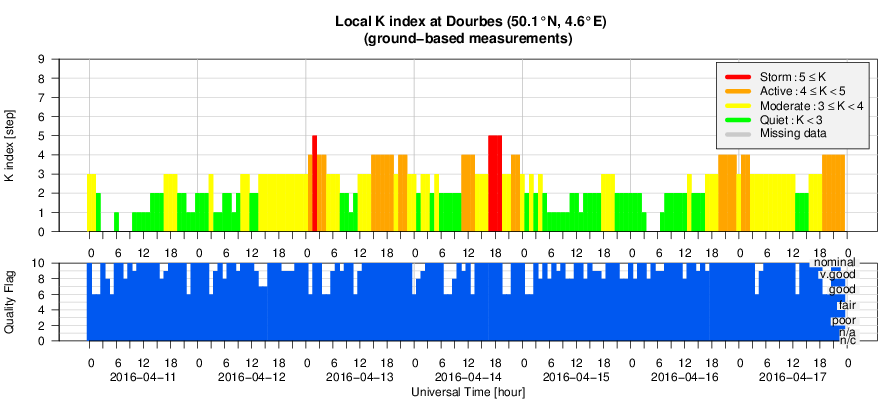- Table of Content
- 1.Dynamic NOAA 2...
- 2.The STCE in 20...
- 3.Space Weather ...
- 4.PROBA2 Observa...
- 5.Review of sola...
- 6.The Internatio...
- 7.Review of geom...
- 8.Geomagnetic Ob...
- 9.Review of iono...
- 10.Future Events
- 11.New documents ...
2. The STCE in 2014
3. Space Weather REDI Bootcamp
4. PROBA2 Observations (11 Apr 2016 - 17 Apr 2016)
5. Review of solar activity
6. The International Sunspot Number
7. Review of geomagnetic activity
8. Geomagnetic Observations at Dourbes (11 Apr 2016 - 17 Apr 2016)
9. Review of ionospheric activity (11 Apr 2016 - 17 Apr 2016)
10. Future Events
11. New documents in the European Space Weather Portal Repository
Dynamic NOAA 2529
Over the last two weeks, the Sun's outlook has been dominated by the big active region NOAA 2529. This sunspot group was relatively quiet, producing only a handful of low-level C-class flares... before erupting in a strong M6 flare early on 18 April. Despite being quiet most of the time, close examination of the available imagery showed important dynamics in the region, in particular the main spot. Note that at its maximum size, the main spot had a diameter of almost 5 times that of the Earth, and its total surface area was over 5 times that of our planet. No need to say this was an easy naked-eye object for solar observers (using eclipse glasses of course!).
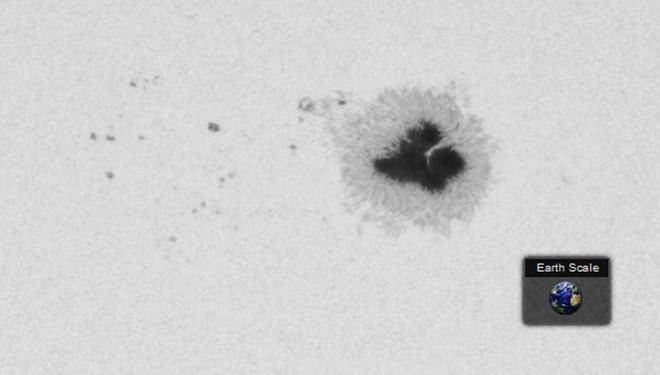
The movie at https://youtu.be/RiX6k3PCBck covers the period from 9 April (08:00UT) till 18 April (08:00UT). SDO (http://sdo.gsfc.nasa.gov/ ) imagery was used, and the clips were created using JHelioviewer (http://www.jhelioviewer.org/ ). The beginning and end of the first clips are somewhat blurred, as the main spot was being tracked by the software and at those times the region was close to resp. the east and west solar limb. The white light clip shows the evolution of the main spot, with important movement from the penumbra (the grayish zone of the spot) into the umbra (the dark center of the spot), as well as some outward motions. The fine, slowly moving bright structures that can be seen intruding the umbra are called light bridges and usually herald the decaying phase of the spot.
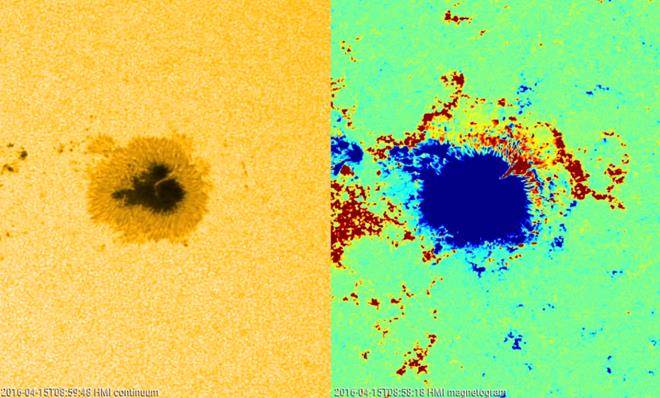
The next clip is a magnetogram laid over the white light image. Red denotes positive magnetic polarity (field lines coming out of the solar surface), while blue represents negative polarity (field lines returning to the solar interior). One can easily see the overall negative polarity of the main spot, but with small magnetic elements of both polarities streaming away from the sunspot. At the start of the clip, there's an intense reddish area to the east of the spot, becoming less bright while moving to the north, then intensifying again as it arrives to the west of the main spot (end of the clip). This is a result of line-of-sight effects when measuring the magnetic fields as the spot is close to the solar limb. See this news item at http://sidc.oma.be/news/188/welcome.html for further explanations. There's also a distinct magnetic flux of positive magnetic polarity streaming outward along the main light bridge to the northwest. This is not a line-of-sight effect.
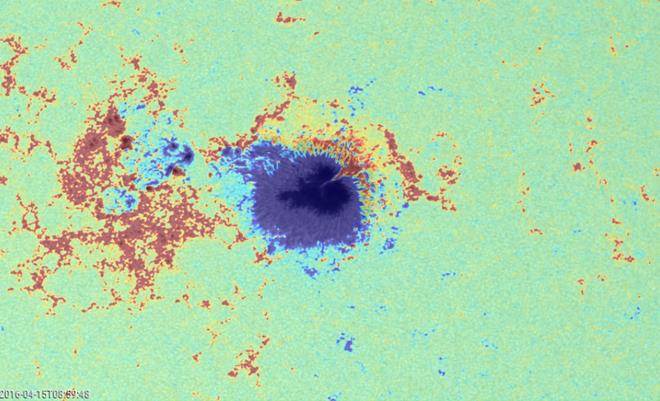
The next two clips link the surface imagery to images in the extreme ultraviolet (EUV). In "warm" temperatures of about 700.000 degrees (AIA 171 filter), a kind of fan-like structure can be seen developing, with a suggestive counter-clockwise rotation. Overlaid on the white light image, it is clear that it has its center in the main spot. See image below. Fully grown by 12 April, it had dissolved already 2 days later.
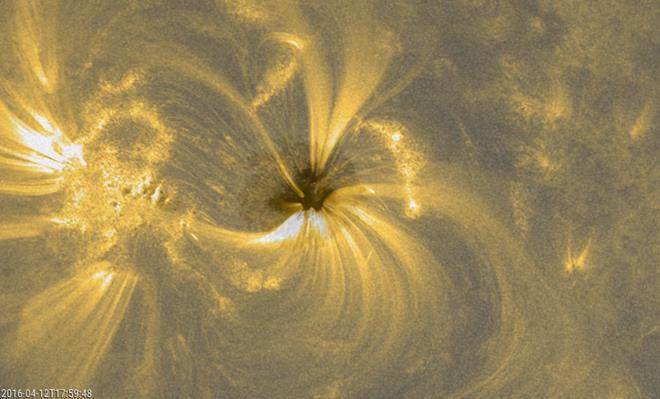
In "hot" temperatures of several million degrees (AIA 094 filter), the fan-like structure is less obvious but nonetheless still present because part of the filter's passband relates somewhat to AIA 171's lower temperatures. Overlaid on the magnetogram, one has a good view on the (sub) flaring activity and on the magnetic field lines connecting areas of opposite polarity, in particular from the "negative" spot to the positive trailing portion of the group but also to the mostly spotless positive magnetic area in front (to the west) of the main spot. See image below.
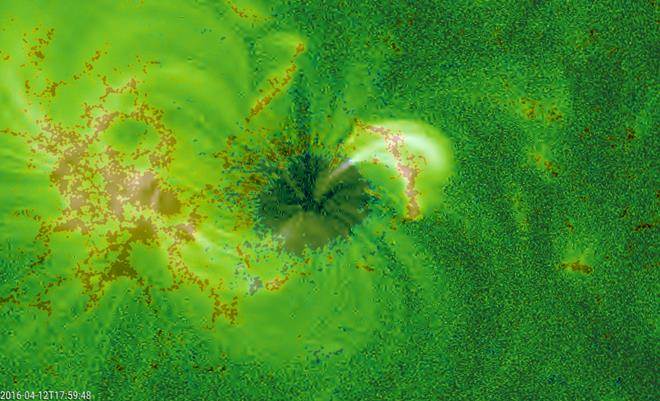
The whole EUV structure is reminiscent of an "anemone" or a "fountain". This magnetic configuration is known for its strong flaring potential, but at the same time it is also notoriously difficult to predict the timing. A well-known example was observed in 2014, with the otherwise very quiet NOAA 2158 producing an M4 and X1 flare on resp. 9 and 10 September. See this news item at http://www.stce.be/news/268/welcome.html , and the comparison underneath (EUV image overlaid on white light image).
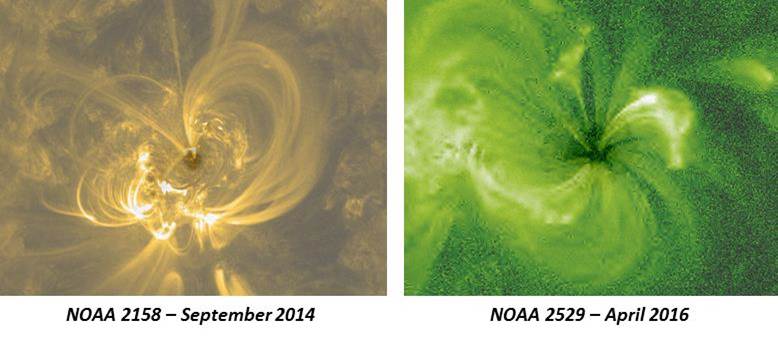
NOAA 2529 was already decaying when it produced an M6 flare early on 18 April. The location of the flare was to the northwest of the main spot. In the clip, the purple hues are from AIA 094, while the green colors are from AIA 171. See image below. Material is ejected into space (but not to Earth), and the post-flare coronal loops are impressive. Solar scientists are going to have a lot of fun researching this dynamic and deceptively quiet sunspot group.
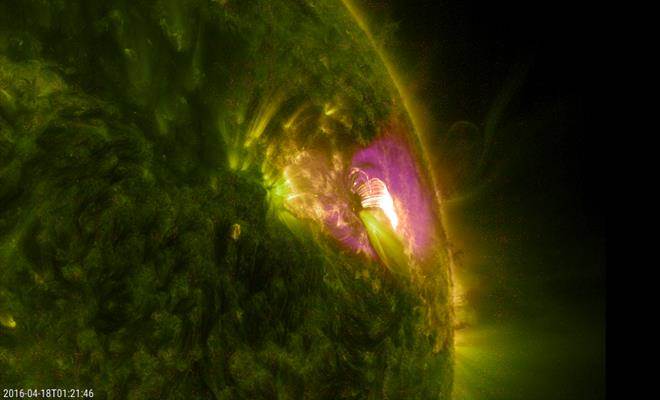
The STCE in 2014
The STCE Annual Report 2014 is now available at http://www.spaceweather.eu/en/repository/show?id=601
It is a compilation of the activities done in 2014 within the frame of the Solar-Terrestrial Centre of Excellence (STCE). This report continues the style from the previous editions. Hence, as it is targeting a more general public, it presents only a selection of the 2014-activities in easy-to-digest summaries. These summaries emphasize the intense collaboration between the institutes at the Space Pole, as well as with our external partners.
We hope you enjoy this report, which features articles on solar and space weather activity, the Open Doors at the Space Pole, the 11th European Space Weather Week, helmet streamers, a new solar coronagraph, total solar irradiance, the Belgian ALC network, SPENVIS-NG, and much more...
We wish you an enjoyable reading experience!
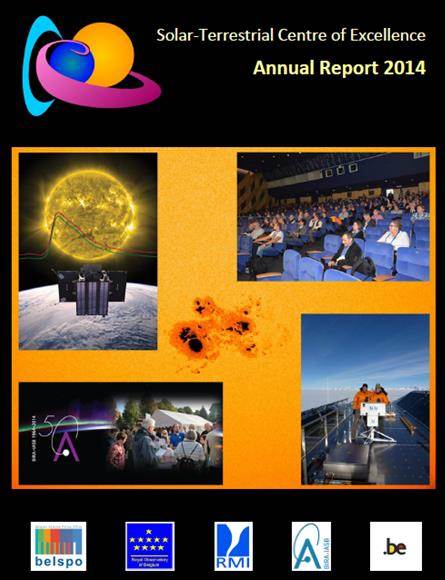
Space Weather REDI Bootcamp
This summer, take advantage of a unique opportunity to explore the burgeoning field of space weather!
SW REDI summer Bootcamp is a two-week free training in space weather, with the first week focusing on the fundamentals of space weather and the second week on intensive forecaster training, with alternative opportunities to discuss research topics with the CCMC and NASA GSFC scientists.
The program is ideal for undergraduate and graduate students interested in space weather forecasting or in space weather related research but is also beneficial for scientists, engineers, educators, mission operators, competitive high school students and all others seeking to gain some basic knowledge regarding space weather.
Check http://ccmc.gsfc.nasa.gov/support/SWREDI/bootcamp/
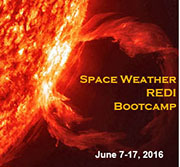
PROBA2 Observations (11 Apr 2016 - 17 Apr 2016)
Solar Activity
Solar flare activity remained low during the week.
In order to view the activity of this week in more detail, we suggest to go to the following website from which all the daily (normal and difference) movies can be accessed:
http://proba2.oma.be/ssa
This page also lists the recorded flaring events.
A weekly overview movie can be found here (SWAP week 316).
http://proba2.oma.be/swap/data/mpg/movies/weekly_movies/weekly_movie_2016_04_11.mp4
Details about some of this week's events, can be found further below.
Saturday Apr 16
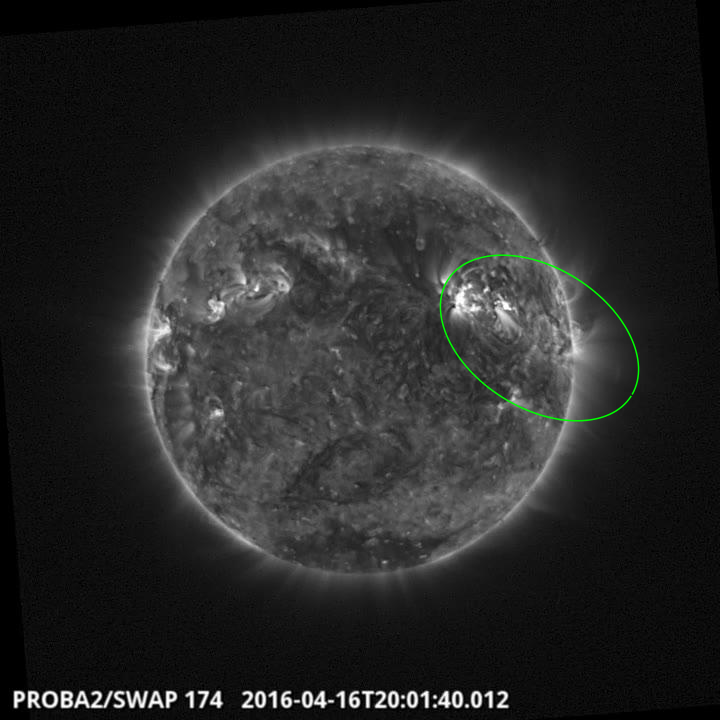
An eruption was observed by SWAP on the west half at 20:01 UT on 2016Apr16
Find a movie of the events here (SWAP movie)
http://proba2.oma.be/swap/data/mpg/movies/20160416_swap_movie.mp4
Review of solar activity
Flaring levels were low throughout the week. NOAA AR 2529 was the only active region releasing flares. It produced 13 C flares, the brightest one being a C5.8 flare which peaked at 19:58 UT on April 16. Find below a chart with the distribution of the flares over the week and a SDO/HMI pictures of the sunspot associated with NOAA AR 2529.
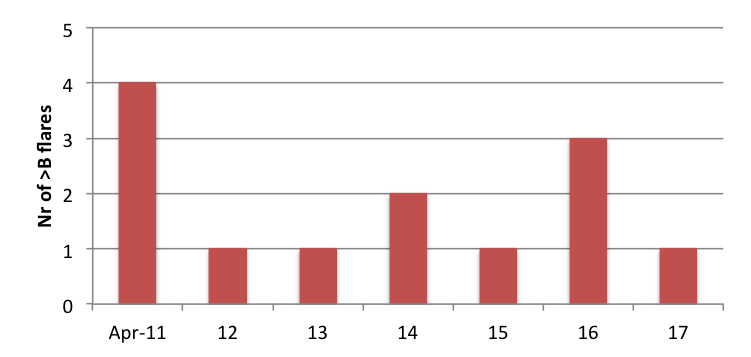
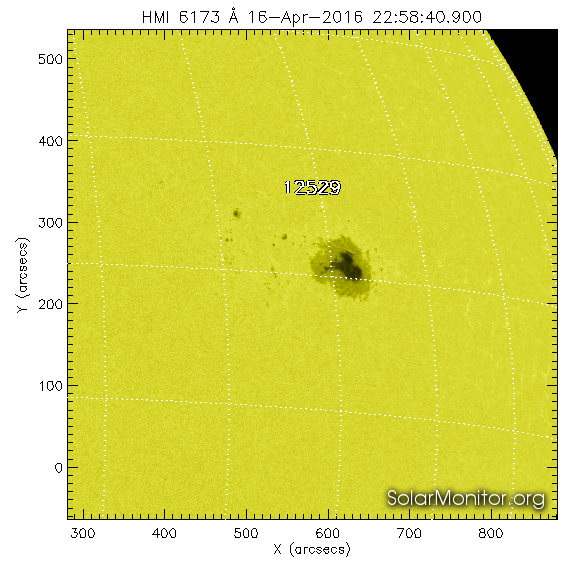
A filament eruption centered near N10E25 was observed around 10:13 UT on April 10 and an associated CME was first observed by LASCO C2 at 11:48 UT.
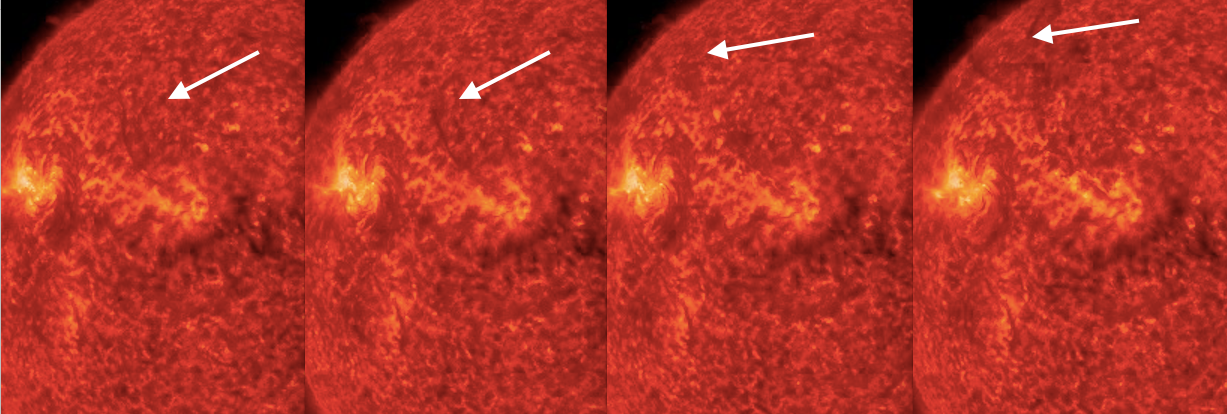
Another CME, related to flaring activity in AR 2529, was first observed by LASCO C2 at 7:48 UT on April 10.
The International Sunspot Number
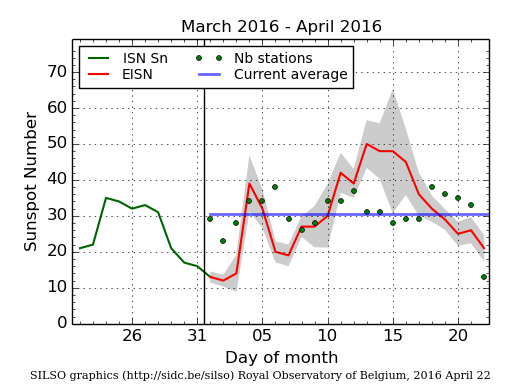
The daily Estimated International Sunspot Number (EISN, red curve with shaded error) derived by a simplified method from real-time data from the worldwide SILSO network. It extends the official Sunspot Number from the full processing of the preceding month (green line). The plot shows the last 30 days (about one solar rotation). The horizontal blue line shows the current monthly average, while the green dots give the number of stations included in the calculation of the EISN for each day.
Review of geomagnetic activity
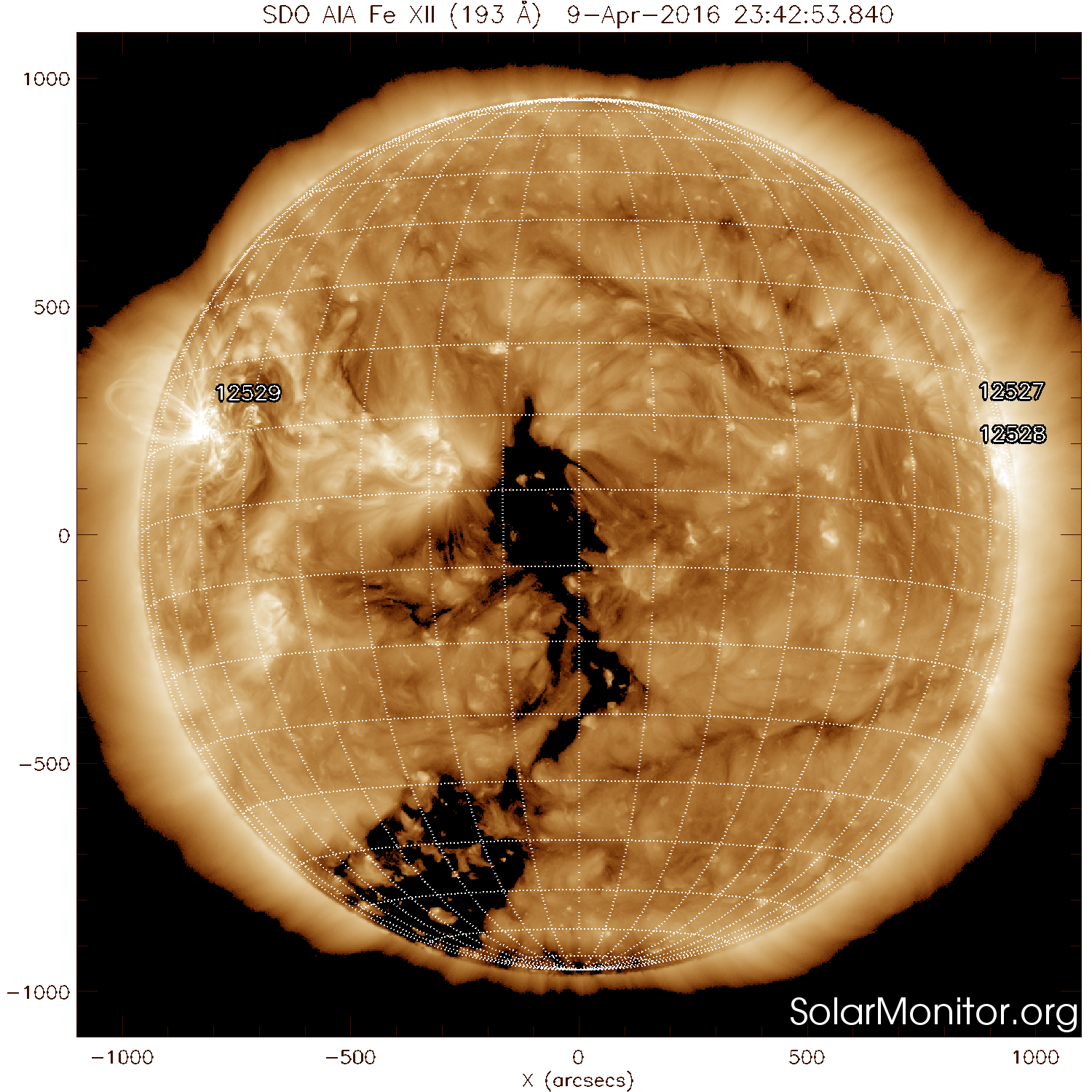
ACE solar wind parameters showed the arrival of a coronal hole (see above SDO/AIA image, southern hemisphere) high speed stream ( indicated in green in graph below) on April 12. The speed increased from around 18h UT on April 12, reaching a peak of around 700 km/s at around 6h UT on April 13. Simultaneously, the magnitude of the Interplanetary Magnetic Field increased till around 17 nT, while the Bz component of the magnetic field decreased till -14 nT and remained mostly negative on April 13. In response, minor geomagnetic storm conditions have been recorded around 0h UT on April 13.
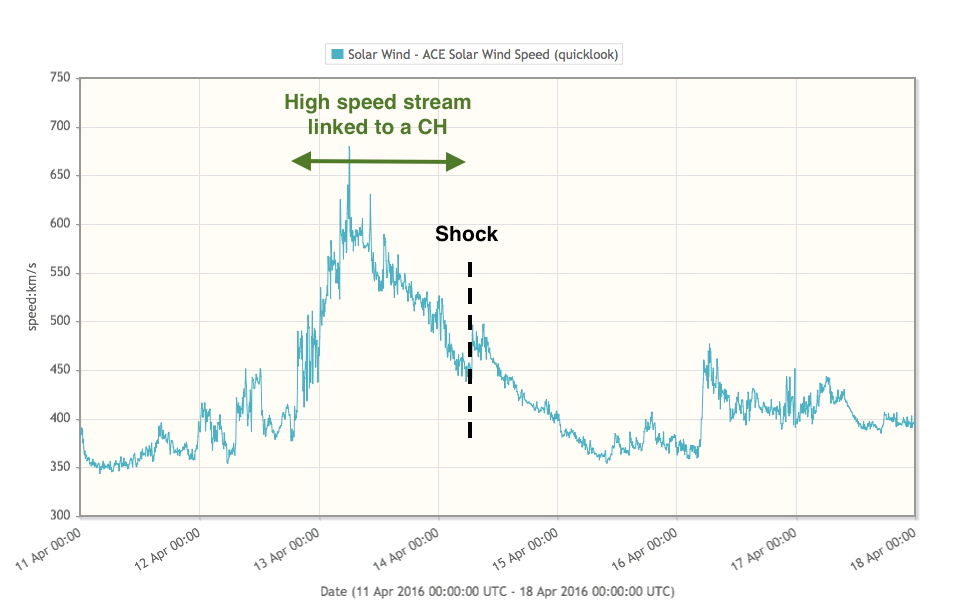
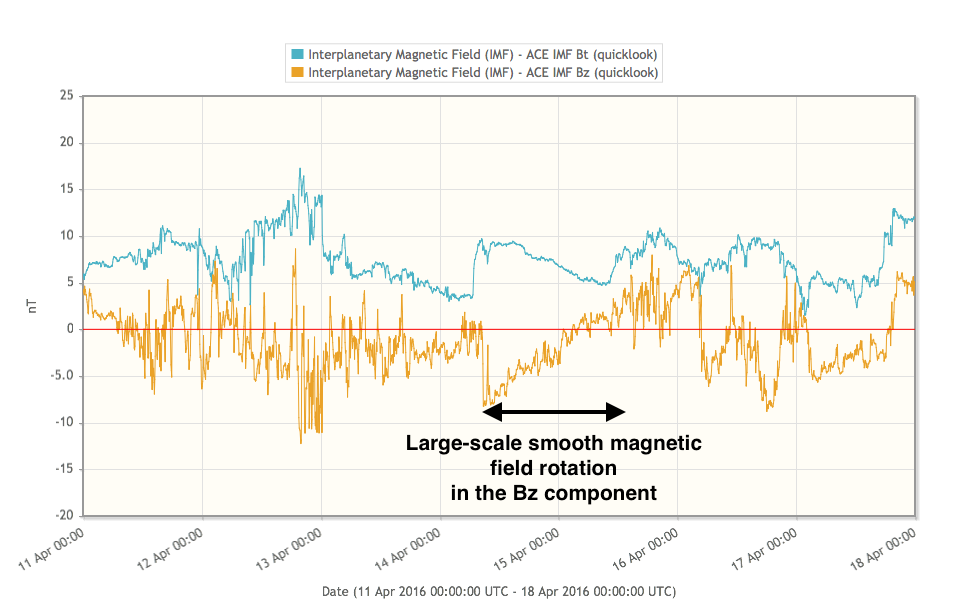
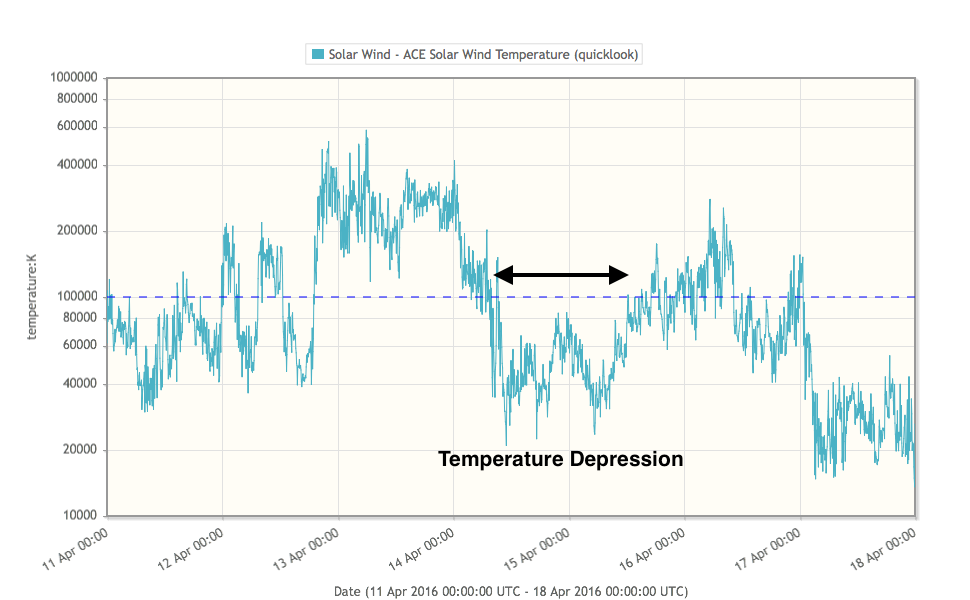
A weak shock in the solar wind was registered by ACE at 6:54 UT on April 14, lifting the solar wind speed to about 490 km/s. This shock probably corresponds to the April 10 CMEs. The magnitude of the Interplanetary Magnetic Field increased from 4 to 10 nT. In the graphs above, the present ICME signatures are indicated in black.
Combined with negative Bz values, this resulted in K Dourbes values of 5 (minor storm) from 17h to 19h on April 14.
Review of ionospheric activity (11 Apr 2016 - 17 Apr 2016)
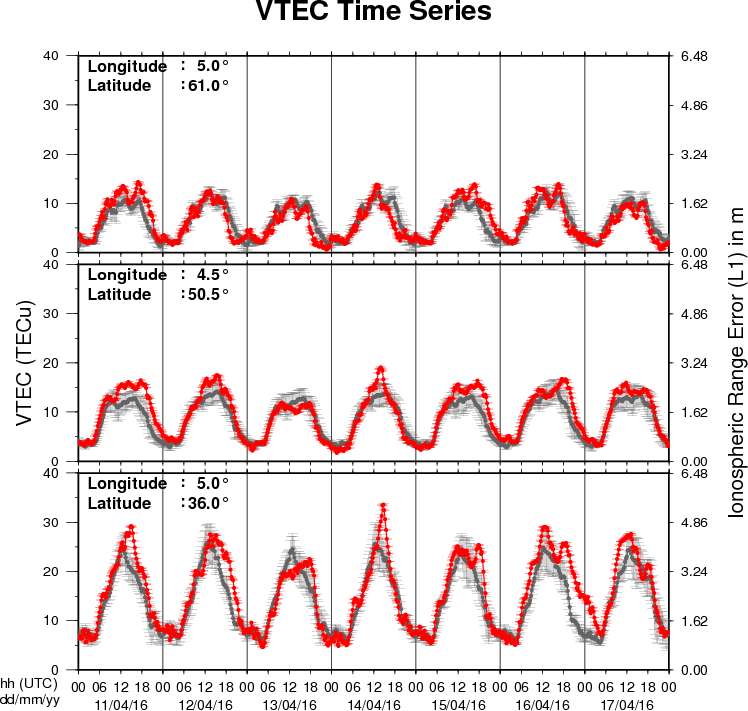
The figure shows the time evolution of the Vertical Total Electron Content (VTEC) (in red) during the last week at three locations:
a) in the northern part of Europe(N61°, 5°E)
b) above Brussels(N50.5°, 4.5°E)
c) in the southern part of Europe(N36°, 5°E)
This figure also shows (in grey) the normal ionospheric behaviour expected based on the median VTEC from the 15 previous days.
The VTEC is expressed in TECu (with TECu=10^16 electrons per square meter) and is directly related to the signal propagation delay due to the ionosphere (in figure: delay on GPS L1 frequency).
The Sun's radiation ionizes the Earth's upper atmosphere, the ionosphere, located from about 60km to 1000km above the Earth's surface.The ionization process in the ionosphere produces ions and free electrons. These electrons perturb the propagation of the GNSS (Global Navigation Satellite System) signals by inducing a so-called ionospheric delay.
See http://stce.be/newsletter/GNSS_final.pdf for some more explanations ; for detailed information, see http://gnss.be/ionosphere_tutorial.php
Future Events
For more details, see http://www.spaceweather.eu/en/event/future
Space Weather REDI Bootcamp
Start : 2016-06-07 - End : 2016-06-17
SW REDI summer Bootcamp is a two-week free training in space
weather, with the first week focusing on the fundamentals of space
weather and the second week on intensive forecaster training, with
alternative opportunities to discuss research topics with the CCMC
and NASA GSFC scientists.
The program is ideal for undergraduate and graduate students
interested in space weather forecasting or in space weather related
research but is also beneficial for scientists, engineers,
educators, mission operators, competitive high school students and
all others seeking to gain some basic knowledge regarding space
weather.
Website:
http://ccmc.gsfc.nasa.gov/support/SWREDI/bootcamp/
The Scientific Foundation of Space Weather
Start : 2016-06-27 - End : 2016-07-01
Website:
http://www.issibern.ch/program/workshops.html
New documents in the European Space Weather Portal Repository
See http://www.spaceweather.eu/en/repository
STCE - De Zon
This is the theoretical course on the Sun and Spaceweather at the MIRA Solar Observatory in their lecture series for beginning amateur astronomers. Given on 13 April 2016 for 40 attendees.
http://www.spaceweather.eu/en/repository/show?id=600
STCE Annual Report 2014
The STCE Annual Report 2014 is a compilation of the activities done in 2014 within the frame of the Solar-Terrestrial Centre of Excellence (STCE). This report continues the style from the previous editions. Hence, as it is targeting a more general public, it presents only a selection of the 2014-activities in easy-to-digest summaries. These summaries emphasize the intense collaboration between the institutes at the Space Pole, as well as with our external partners. We hope you enjoy this report, which features articles on solar and space weather activity, the Open Doors at the Space Pole, the 11th European Space Weather Week, helmet streamers, a new solar coronagraph, total solar irradiance, the Belgian ALC network, SPENVIS-NG, and much more... Happy reading!
http://www.spaceweather.eu/en/repository/show?id=601
